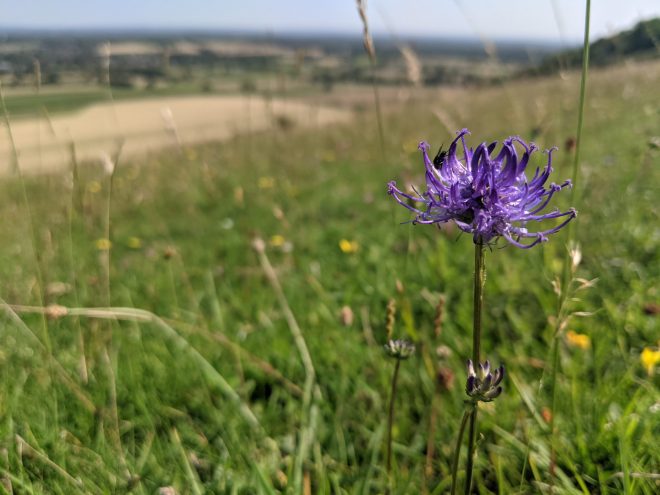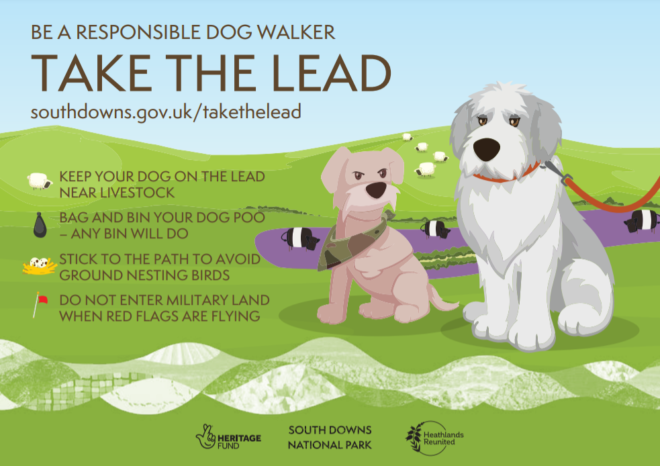Essential work under way to protect Site of Special Scientific Interest
October 7, 2021

Vital work has begun to protect an important wildlife and grazing site in the South Downs National Park.
Fencing is being installed on both sides of the bridleway heading north-west from The Clayton Windmills, in West Sussex, to protect a wildlife-rich site and the conservation grazing livestock that help to conserve it.

The priority is to protect the site and the animals that keep it special, while also ensuring there is no adverse impact to the right of way. The Site of Special Scientific Interest (SSSI) has one of the highest levels of wildlife protection due to its rare chalk grassland species, including the round-headed rampion and several butterfly species.
The fencing is necessary to protect this site on a privately-owned farm after a long list of incidents and attacks where dogs have been allowed to run off lead, chasing, attacking and killing livestock and causing others to be harmed as they are chased through fences.
The work is being carried out by the farmer, with support from the National Park Authority and West Sussex County Council, as well as permission from Natural England.
There will still be access to the site via the bridleway and South Downs Way – routes that offer stunning views of the landscape and “Jack and Jill” windmills. A grass bund next to the car park is also a good spot to enjoy the views.. Tours of the windmill will be unaffected.
Farmer Gary Lee said: “Due to the popular location we’ve been forced to fence the official right of way and stop people from walking everywhere, so that we can successfully graze the chalk SSSI grassland without our livestock being chased by dogs. We know so many people love this site as much as we do. Please help us conserve it by sticking to the right of way, keepings dogs on the lead and taking home your rubbish.
“I would like to thank the South Downs National Park Authority, Natural England and West Sussex County Council for their support in this project.”
The longer-term plan, subject to permissions, will be to divert the pathway to the edge of the farmer’s field, rather than passing through the centre of it as it currently does.
Nigel James, a Countryside and Policy Manager, who leads access for the National Park Authority, said: “This is a particularly sensitive wildlife site that has experienced a very high number of visitors over the past 18 months.
“This privately-owned farm has never been open access land, but the amazing views will always be there for people to enjoy through the extensive rights of way network.
“Our core aim is to prevent serious damage by dogs to this sensitive wildlife site without having an adverse impact on access. This work does not prevent access to areas that people are legally entitled to go.
“It’s important that we all help care for this wonderful chalk grassland site that supports an array of rare plants and invertebrates.
“We believe the additional fencing will be an effective solution in the short-term.
“Through our Take The Lead campaign, we welcome responsible dog walking in the National Park and we would advise dogs to be on leads anywhere near livestock.”
For more information on Take The Lead visit www.southdowns.gov.uk/take-the-lead/

- The fencing will be about 180m in length alongside the path.
- Chalk grassland is one of the rarest habitats in the world and was of the reasons the South Downs National Park was created 11 years ago as a protected landscape for the nation. Often called “Europe’s tropical rainforest in miniature”, just one square metre can support up to 40 different wildflowers and over 20 different species of butterfly on the wing at any one time.
- Chalk grasslands have declined over the past century and now cover just four per cent of the National Park’s area. The National Park Authority works closely with farmers and partners to protect what remains and reverse the decline.
- Conservation grazing, by cows and sheep, is one of the main ways to protect existing chalk grassland as the grazers act like “ecosystem engineers”, maintaining the grassland habitat and the diversity of flora which in turn supports a range of animal species like bees and butterflies.
